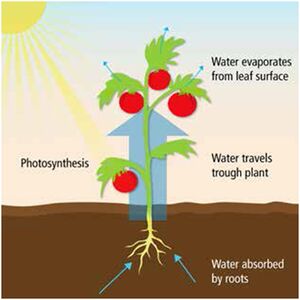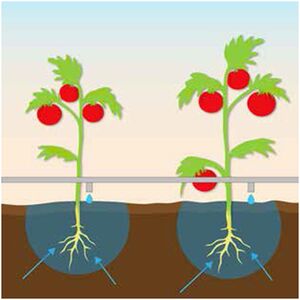Difference between revisions of "SPIS Toolbox - Irrigation Principles"
***** (***** | *****) m |
***** (***** | *****) m |
||
| Line 10: | Line 10: | ||
By irrigating, the soil water storage in the plant root zone is replenished. Instigated by the sun and photosynthesis, plants abstract soil moisture with their roots. This triggers a nutrient flow through the stem to the leaves, from where the water is '''transpired '''back to the atmosphere. Thus, only the water that is taken up through the root system contributes to plant and fruit growth. | By irrigating, the soil water storage in the plant root zone is replenished. Instigated by the sun and photosynthesis, plants abstract soil moisture with their roots. This triggers a nutrient flow through the stem to the leaves, from where the water is '''transpired '''back to the atmosphere. Thus, only the water that is taken up through the root system contributes to plant and fruit growth. | ||
| − | {| style="width: | + | {| style="width: 580px" cellspacing="1" cellpadding="1" border="0" |
|- | |- | ||
| style="background-color: rgb(153, 153, 102)" | | | style="background-color: rgb(153, 153, 102)" | | ||
Revision as of 13:50, 2 June 2017

Introduction
The Toolbox on Solar Powered Irrigation Systems (SPIS) is designed to enable advisors, service providers and practitioners in the field of solar irrigation to provide broad hands-on guidance to end-users, policy-makers and financiers. Risks related to system efficiency, financial viability and the unsustainable use of water resources can thus be minimized. The Toolbox comprises informative modules supplemented with user-friendly software tools (calculations sheets, checklists, guidelines). read more
Modules and tools touch upon:
- assessing the water requirements,
- comparing the financial viability,
- determining farm profitability and payback of investment in SPIS,
- sustainably design and maintain a SPIS,
- highlight critical workmanship quality aspects,
- and many more.

Irrigation Principles
Irrigation is the controlled application of water to respond to crop needs. Water used for irrigation may be taken from nearby lakes, reservoirs, rivers or wells (groundwater), but also from non-conventional sources such as treated wastewater, desalinated or drainage water. Irrigation water is brought to cultivated land by pipes, hoses or ditches.
Producers who irrigate are less dependent on irregular rainfall for their production. Producers can supplement rainfall with irrigation to respond to the amount of water the crop needs. Moreover, control over water improves the efficiency of other yield-improving inputs such as fertilizers and plant protection products. Consequently, the producer’s ability to control the yields is enhanced. This is important for stable productivity and integration into markets.
By irrigating, the soil water storage in the plant root zone is replenished. Instigated by the sun and photosynthesis, plants abstract soil moisture with their roots. This triggers a nutrient flow through the stem to the leaves, from where the water is transpired back to the atmosphere. Thus, only the water that is taken up through the root system contributes to plant and fruit growth.
|
Important: Most of the water that is brought to the field via irrigation should concentrate around the root zone of the plant and the volume of water irrigated should not exceed the plants’ ability to absorb it. |





















